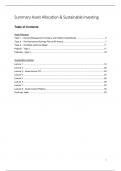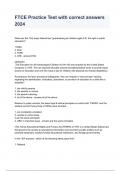Summary Asset Allocation & Sustainable Investing
Table of Contents
Asset Allocation
Topic 1 – Harvard Management Company and Inflation-linked Bonds .................................................2
Topic 2 – The Harmonized Savings Plan at BP-Amoco .......................................................................7
Topic 3 – The Black-Litterman Model ................................................................................................ 11
Podcast - Topic 1 .............................................................................................................................. 17
Podcasts - topic 2 ............................................................................................................................. 18
Sustainable Investing
Lecture 1 .......................................................................................................................................... 19
Lecture 2 .......................................................................................................................................... 20
Lecture 3 – Guest lecture CTI ........................................................................................................... 22
Lecture 4 .......................................................................................................................................... 24
Lecture 5 .......................................................................................................................................... 26
Lecture 6 .......................................................................................................................................... 29
Lecture 7 .......................................................................................................................................... 30
Lecture 8 – Guest Lecture Robeco .................................................................................................... 32
Summary Table ................................................................................................................................ 33
1
, Asset Allocation
323039-M-6 Lieven Baele 2023-2024
Topic 1 – Harvard Management Company and Inflation-linked Bonds
“Should HMC add inflation-linked bonds as an additional asset class?”
Strategic Asset Allocation
• Vigorous immortality: you want to have impact now (vigorous) but also want to impact the long term.
• Real spending/return: before inflation
• Strategic asset allocation:
- Long-term allocation to broad asset classes (equity, bonds etc)
- Maximize risk-return trade-off given inherent risk/return asset class characteristics
- Periodical rebalancing towards long-term weights
➔ Drivers: Risk profile and financial goals
• Tactical asset allocation:
- Active strategy, deviating from the market, based on changing market circumstances
o Instead of overpriced stocks choose sustainable stocks
- Determined by “market timing”, tilt weights toward assets you expect to do well
➔ Driver: External factors
• Monthly variation in return of a single balanced mutual fund is due to strategic allocation of 80-90%
- Fund managers stick relatively close to their strategic allocation and remain rather passive in
their implementation
- But variation in 10-year is 35%-40%, other factors: asset-class timing, security selection, fees
• Role of policy portfolio for HMC:
1. Long-run/strategic asset allocation of the endowment over main asset classes
2. Benchmark for performance measurement (evaluate managers and endowment)
3. Determined by quantitative techniques (Framework: Mean-Variance Optimization)
o Specify objective (utility function)
o Specify asset classes
o Capital market Assumptions (ER, Vol, Cor)
o Optimization (w or w/o constraints)
o Black testing → implementation → follow up
Importance of Equity Exposure
Why should long-term portfolio include equities?
Rule 1: Do not neglect Equities
• Equity Participation puzzle: very few people hold equity stocks, while their average return is 5.5%
higher than bonds.
- Equities are risky in the short-run (worst: -40%), but in the long-run more profitable (worst: 6%)
- MVA can’t explain equity under participation, even for unrealistically high-risk aversion you still
get 20% allocation to equities
• Behaviour Finance can explain:
- Loss Aversion: feel worse about losses than feel good about gains
- Myopia (short-sightedness): check the value of their portfolio too regularly (vigilance). Assets
of higher levels of volatility have a higher incidence of periods with losses → considered riskier
➔ (Myopic) Loss aversion: Avoid assets with frequent (short-term) losses, such as stocks. But
ignoring superior long-term returns.
- Probability Overweighting added to myopic loss aversion may further deter investors from
investing in stocks.
o Overestimate extreme events and underestimate large probability events
Rule 2a: Diversify Idiosyncratic Risk
• Risk-taking (and hence equity market participation):
- Genetically determined
- Increases: wealth, IQ, financial literacy and trust in institutions/systems
- Decreases with past bad experiences
• Firm-specific (Idiosyncratic) risk (scandals, bad news) can be diversified, systematic risk not.
2
, - Need 30-50 different stocks to eliminate most idiosyncratic risk
- Portfolios with large amounts of idiosyncratic risk are inefficient
• Diversify the portfolio to remove firm-specific risk by:
- Invest internationally
- Combine poorly correlated asset classes
Rule 2b: Diversify Internationally?
• Home bias puzzle: the tendency of investors to favour domestic assets over international ones,
despite the potential benefits of diversification
- CAPM: invest the same in a market as their index but: Global index eight < Investor holdings
in domestic equities
- Reasons for home bias:
o Asymmetric information, more information about home stocks than foreign stocks
o Volatility of the Global Equity Portfolio is the lowest, suggesting substantial benefits to
international diversification.
▪ When there is a gap, this country has incentives to invest in foreign stocks
▪ Reduction in volatility is smaller for the US than for other markets
• Problem: higher correlation between countries → less profit from internationally diversification
- Interlinked economies → correlated CFs
- Global equity market → all exposed to the same market sentiment through the discount rate
- “Mood Shifts” affect equity valuations all across the globe
- Crises in one market directly transmit to other markets (contagion)
- Excess returns are the result of positive CF news or negative Discount Rate News
• Paper of Viceira and Wang: long-horizon investors still benefit from substantial benefits of international
diversification
- Discount rate shocks are mean-reverting rapidly → not increase long-horizon correlations
- Cash Flow shocks are highly persistent, potentially leading to permanently higher long-horizon
correlation. But do not find cash flow shocks to be highly correlated.
Rule 2c: Emerging and Frontier Markets as Diversifiers?
• Emerging markets: include countries that are in the process of becoming a developed economy
• Frontier markets: early stage of development, less advanced economies in the developing world
• Why invest in Emerging/Frontier markets?
- They grow faster
- Higher diversification
- Less investors so less competitive
• Gordon Growth model:
• Implication 1: High expected growth (g) is already embedded in current market valuations
- Emerging markets have underperformed, growth has been much lower than in developed
markets
• Implication 2: Lower valuations are due to emerging-specific components in discount rate (r)
- Political, Liquidity, Geopolitical and Currency risk premium
• Diversifiers?
- Emerging markets are very correlated with devolved markets, frontier markets less correlated
- Little bit of diversification
Rule 3: Diversify into other asset classes
• The Endowment model: theory and practice of investing in highly diversified long-term portfolios,
which include allocations to less traditional and less liquid asset categories (private equity, real estate,
absolute return strategies)
Hedge funds:
• Hedge fund: limited parentship of private investors whose money is managed by fund managers
- Characteristics: held by sophisticated investors (pension) → less regulated, levered (borrow to
invest), flexible investment strategy, high fees
• High diversification potential: if they can time the market they can go long and short, correlation of -1
3
, - During crisis: The losses are lower, but they miss the revival of the market
- High correlation with 60/40 portfolio
• Performance: Beginning very high returns, but performance lowers (lost market share to ETF’s)
- Flights-to-safe: drop risky assets and run to save assets
- Search of yield is “over”, what happens to hedge funds? → Hedge funds have to deliver
performance, way above US treasury bonds.
Private Equity
• Private equity: Equity of companies that is directly sold to investors
- Characteristics: less regulated, heavy fees, diverse investment strategy, levered: 2/3 debt
financing, illiquid investment (5-10y)
• Selling story:
- Earn illiquidity premium: access to increasing market of non-listed equity
- Capacity to better control firms: PE firms tend to own substantial stakes and longer investment
horizons, turning “sluggish businesses into world-beaters”.
• Performance: no overall statement → difficult to access the true value of returns, there is no market
price, only the value of the companies
- PE outperforms standard public equity benchmarks before cost
- PE performance compared to appropriate benchmarks (small firms), PE underperforms
- PE performance has gone down over time. But still a lot of money has flown into it
• Motives investors:
1. Seeking leverage: You want to take on additional risk, but you are limited by internal rules.
You can implicitly take on leverage by investing in PE
2. Appreciate that PE returns are artificially smooth
o Valuations rely on self-appraisal, PE returns move less than public market returns
o In crisis: PE portfolio drops less
o Manager of mixed funds is less likely to be forced to sell at rock-bottom prices
because of imposed risk constraints or solvency rules
o Increases the portfolio’s Sharpe Ratio
Real estate
• Real Estate: the land and any permanent structures, the largest alternative asset class.
- Characteristics: provide dividends, reliable/annual income (pension funds)
- Two types: Residential & Commercial
• How to invest?
- Direct purchase of property
- Participation in private real estate fund
- Listed Real Estate Investment Trusts (REITs)
- Other (fund-of-fund, limited parentships)
• Performance: Attractive risk-return trade-off (good Sharpe Ratios), historically high returns (high house
prices) and offer high dividends (reliable income)
- But have high volatility and high correlation with equity market
• Urban Doom loop: Covid-19 has driven changes in working patterns, causing a decline in the
demand for commercial real estate resulting in substantial drops in renting prices → less taxed for
local governments. Forced to increase local tax rate or reduce investment in local infrastructure
(policy, public transport)
- Valuations are also affected by increasing interest rates and requests to make buildings more
sustainable.
- Buildings owned by highly levered real estate funds, middle-sized US banks lend to them →
risk of major fund defaults
➔ Not only the US but also an international problem
Commodities
• Commodities: basic goods of comparable quality. 4 basic groups: Energy (crude oil, gas...), Metals,
Livestock, Agriculture
• Methods before: trading mainly between producers and firms using them as input in their production
- More recent: investors take exposure using futures contract
4





